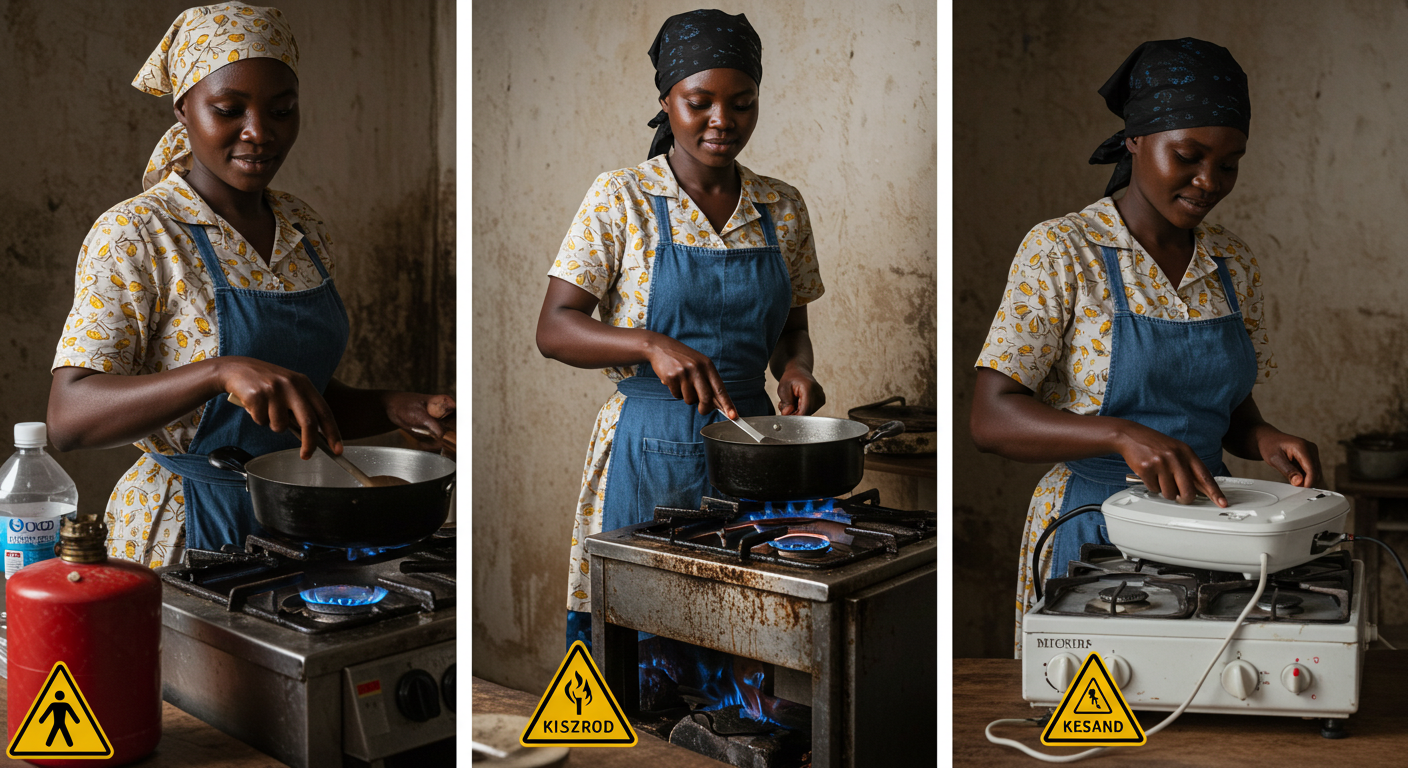
...
Cooking is the heart of any home, but using fuel sources like gas, electricity, wood, or charcoal can turn your cozy kitchen into a risky zone if you’re not careful. From gas leaks to electrical fires, mishandling fuel sources can lead to burns, fires, or even carbon monoxide poisoning. Globally, kitchen fires account for a significant portion of household accidents, with reports from fire safety organizations noting that unattended cooking is a leading cause. Whether you’re simmering stew on a gas stove or grilling over charcoal, understanding the risks is your first step to staying safe.
Common Issues:
- Gas Stoves: Leaks, improper ventilation, or flame blowouts.
- Electric Stoves: Overheating, faulty wiring, or appliance malfunctions.
- Wood/Charcoal: Smoke inhalation, uncontrolled flames, or improper fuel storage.
- All Fuels: Unattended cooking, cluttered workspaces, or lack of safety equipment.
Don’t worry—we’ve got your back! Let’s dive into practical solutions to keep your kitchen safe and your meals delicious.
🍳 7 Proven Strategies for Safe Cooking with Various Fuel Sources
Here are seven actionable strategies to cook safely, no matter your fuel source. Each includes specifics and explains why it’s effective. The most critical? Never leave cooking unattended—it’s the golden rule of kitchen safety!
1. Never Leave Cooking Unattended ✨
How it helps: Unattended cooking is the leading cause of kitchen fires worldwide. Staying present allows you to spot and address issues like spills, flare-ups, or equipment malfunctions immediately.
Specifics:
- Stay in the kitchen while frying, grilling, or boiling.
- Use a timer to remind yourself to check on slow-cooking dishes.
- If you must leave, turn off the stove or fuel source first.
Global Tip: In busy households worldwide, multitasking is tempting. Keep a small activity (like prepping ingredients) in the kitchen to stay engaged.
2. Check and Maintain Equipment Regularly 🔧
How it helps: Faulty gas lines, worn-out electrical cords, or clogged burners can spark disasters. Regular checks catch issues early.
Specifics:
- Gas: Inspect hoses for cracks; test for leaks with soapy water (bubbles indicate a leak).
- Electric: Look for frayed cords or overheating outlets; unplug appliances when not in use.
- Wood/Charcoal: Ensure grills or stoves are clean and free of ash buildup.
- Schedule professional maintenance annually.
Global Tip: In areas with unreliable electricity or gas supply, double-check backup fuel sources (e.g., portable gas canisters) for safety compliance.
3. Ensure Proper Ventilation 🌬️
How it helps: Good airflow prevents carbon monoxide buildup (especially with gas or wood) and reduces smoke inhalation risks.
Specifics:
- Open windows or use an exhaust fan while cooking.
- For wood/charcoal, cook in well-ventilated spaces, ideally outdoors.
- Install a carbon monoxide detector near the kitchen.
Global Tip: In tropical or urban areas with limited ventilation, portable fans can help circulate air safely.
4. Keep Flammable Items Clear 🧹
How it helps: Curtains, towels, or oil-soaked rags near flames or hot surfaces can ignite quickly.
Specifics:
- Maintain a 3-foot (1-meter) “clear zone” around stoves or grills.
- Store flammable liquids (e.g., cooking oil, alcohol) away from heat sources.
- Use metal or fire-resistant holders for wooden spoons or cloths.
Global Tip: In small apartments or shared kitchens, use wall-mounted storage to keep flammable items out of reach.
5. Use Appropriate Cookware 🍲
How it helps: The right pots and pans prevent overheating, spills, or tipping, reducing fire risks.
Specifics:
- Use flat-bottomed cookware on electric stoves for even heating.
- Choose heavy, stable pots for gas or wood stoves to avoid tipping.
- Ensure handles are heat-resistant and turned inward to prevent knocking over.
Global Tip: In regions using traditional clay or cast-iron pots, ensure they’re rated for your fuel source (e.g., open flame vs. electric).
6. Have Fire Safety Tools on Hand 🧯
How it helps: Quick access to extinguishers or blankets can stop small fires before they spread.
Specifics:
- Keep a Class B or K fire extinguisher (for grease/oil fires) in the kitchen.
- Have a fire blanket for smothering small flames.
- Learn how to use them: Pull, Aim, Squeeze, Sweep (PASS) for extinguishers.
Global Tip: In rural areas, where extinguishers may be scarce, keep a bucket of sand or water (for non-grease fires) nearby.
7. Practice Safe Fuel Storage ⛽
How it helps: Improperly stored gas, charcoal, or wood can lead to leaks or spontaneous fires.
Specifics:
- Store gas canisters upright in cool, ventilated areas away from heat.
- Keep charcoal or wood dry and covered, away from the cooking area.
- Check for local storage regulations (e.g., maximum canister size).
Global Tip: In regions with high humidity, use sealed containers for charcoal to prevent moisture-related hazards.
🛡️ Prevention Strategies: How to Avoid Kitchen Incidents
Prevention is better than putting out fires (literally!). Here are five practical ways to keep your kitchen safe long-term.
Install Smoke and Gas Detectors 🚨
How it helps: Early warnings allow you to address issues before they escalate.
Specifics: Place smoke alarms outside the kitchen and test monthly. Add a gas detector for propane or natural gas setups.
Educate Household Members 📚
How it helps: Everyone knowing basic safety rules reduces risks, especially in shared kitchens.
Specifics: Teach kids and roommates to avoid touching stoves and to report odd smells (like gas).
Create a Cooking Routine ⏰
How it helps: Structured habits minimize distractions and rushed cooking.
Specifics: Prep ingredients beforehand, and avoid cooking when tired or distracted.
Keep a Clean Kitchen 🧼
How it helps: Grease or food buildup can fuel fires or cause slips.
Specifics: Wipe down stoves and counters after each use; clean vents regularly.
Follow Manufacturer Guidelines 📖
How it helps: Using appliances as intended prevents malfunctions.
Specifics: Read manuals for stoves, grills, or heaters, and follow fuel-specific instructions.
⚠️ Crucial Cautions & When to Seek Professional Help
While these tips can keep you safe, some situations require immediate action or professional intervention. Here’s what to watch for:
Important Cautions:
- Don’t Use Water on Grease Fires: Water can spread oil-based fires, making them worse. Use a fire extinguisher or blanket instead.
- Avoid Overloading Electrical Outlets: Plugging too many appliances into one socket can cause overheating or sparks.
- Don’t Ignore Gas Smells: A rotten egg odor could indicate a gas leak—evacuate and call a professional immediately.
- Beware of Panic Actions: For example, frantically dousing a fire with random liquids can worsen it (e.g., sugar water can fuel flames). Stay calm and use proper tools.
Red Flags for Professional Help:
- Persistent gas smells or hissing sounds from gas lines.
- Electrical appliances sparking, smoking, or giving shocks.
- Uncontrollable fires or smoke filling the kitchen.
- Symptoms of carbon monoxide poisoning (headache, dizziness, nausea).
Why It Matters: Acting rashly or ignoring serious signs can escalate minor issues into life-threatening situations. Always prioritize safety and seek experts when in doubt.
🥄 Cook Safely, Share the Love!
Cooking safely means more delicious meals and fewer worries for you and your loved ones. Share this guide with friends and family to keep their kitchens safe, too—it’s a small act that could prevent a big disaster! Have a tip or story about kitchen safety? Drop it in the comments below—we’d love to hear from you!
Disclaimer (Again): This guide is for informational purposes only. For specific safety concerns or emergencies, consult local professionals or emergency services.
Hashtags: #KitchenSafety #CookingTips #FirePrevention #SafeCooking #HomeSafety #GasStoveSafety #ElectricStoveSafety

Add new comment